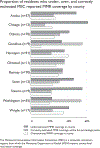Does education about local vaccination rates and the importance of herd immunity change US parents' concern about measles?
- PMID: 33158593
- PMCID: PMC7740073
- DOI: 10.1016/j.vaccine.2020.09.076
Does education about local vaccination rates and the importance of herd immunity change US parents' concern about measles?
Abstract
It is unclear how broadly aware parents are of the concept of herd immunity and whether parents consider community benefits of vaccination when making decisions about their child's vaccinations. We aimed to determine whether educating parents about community-level benefits of measles, mumps, and rubella (MMR) vaccination and local vaccination rates would impact concern about their child's risk of measles and risk of a measles outbreak. We conducted an electronic survey among Minnesota parents of children aged 6-18 years in August 2016. We assessed baseline knowledge of herd immunity, asked participants to estimate MMR vaccination coverage in their county, and asked participants to estimate the minimum coverage needed to prevent measles outbreaks. We then delivered a short, educational intervention via the survey to inform participants about the benefits of herd immunity, the actual MMR vaccination coverage in their county, and that at least 95% MMR vaccination coverage is needed to prevent measles outbreaks. Pre- and post-intervention, participants were asked to report how concerned they were that their child might get measles. We used logistic regression models to assess factors associated with awareness of herd immunity, change in concern about one's child's measles risk, and overall concern for a measles outbreak. Among 493 participants, 67.8% were aware of herd immunity at baseline. Post-intervention, 40.2% (n = 198) of parents learned that MMR vaccination rates in their county were higher than they expected. All participants found out that their county MMR rates were lower than the measles herd immunity threshold of 95%. Overall, 27.0% (n = 133) of participants reported an increase in concern that their child might get measles after learning about local vaccination coverage and the coverage needed to achieve herd immunity. We found that our short, educational intervention aimed to increase awareness about herd immunity and local vaccination led to an increase in concern about disease risk among less than a third of parents.
Keywords: Herd immunity; Indirect protection; MMR vaccination; Measles; Vaccination coverage.
Copyright © 2020 The Authors. Published by Elsevier Ltd.. All rights reserved.
Conflict of interest statement
Declaration of Competing Interest The authors declare that they have no known competing financial interests or personal relationships that could have appeared to influence the work reported in this paper.
Figures






References
-
- Centers for Disease Control and Prevention. Measles History In: Centers for Disease Control and Prevention, editor. Measles (Rubeola); 2018.
-
- Centers for Disease Control and Prevention. Measles Cases and Outbreaks In: Centers for Disease Control and Prevention, editor. Measles (Rubeola); 2019.
-
- McLean HQ, Fiebelkorn AP, Temte JL, Wallace GS. Prevention of measles, rubella, congenital rubella syndrome, and mumps, 2013: summary recommendations of the Advisory Committee on Immunization Practices (ACIP). MMWR Recomm Rep 2013;62:1–34. - PubMed
-
- Centers for Disease Control and Prevention. 1995 through 2017 Childhood Measles, Mumps, and Rubella (MMR) Vaccination Coverage Trend Report In: ChildVaxView, editor; 2015.
-
- Infectious Disease Epidemiology Prevention and Control Division(IDEPC) MIIC and the Public. In: Minnesota Department of Health, editor; 2019.
Publication types
MeSH terms
Substances
Grants and funding
LinkOut - more resources
Full Text Sources
Medical

